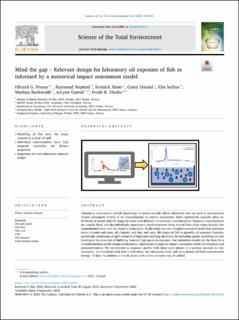| dc.contributor.author | Frøysa, Håvard Guldbrandsen | |
| dc.contributor.author | Nepstad, Raymond | |
| dc.contributor.author | Meier, Sonnich | |
| dc.contributor.author | Donald, Carey | |
| dc.contributor.author | Sørhus, Elin | |
| dc.contributor.author | Bockwoldt, Mathias | |
| dc.contributor.author | Carroll, JoLynn | |
| dc.contributor.author | Vikebø, Frode Bendiksen | |
| dc.date.accessioned | 2023-09-28T11:17:21Z | |
| dc.date.available | 2023-09-28T11:17:21Z | |
| dc.date.created | 2023-09-18T12:49:17Z | |
| dc.date.issued | 2023 | |
| dc.identifier.issn | 0048-9697 | |
| dc.identifier.uri | https://hdl.handle.net/11250/3092693 | |
| dc.description.abstract | Laboratory experiments provide knowledge of species-specific effects thresholds that are used to parameterize impact assessment models of oil contamination on marine ecosystems. Such experiments typically place individuals of species and life stages in tanks with different contaminant concentrations. Exposure concentrations are usually fixed, and the individuals experience a shock treatment being moved from clean water directly into contaminated water and then back to clean water. In this study, we use a coupled numerical model that simulates ocean currents and state, oil dispersal and fate, and early life stages of fish to quantify oil exposure histories, specifically addressing oil spill scenarios of high rates and long durations. By including uptake modelling we also investigate the potential of buffering transient high peaks in exposure. Our simulation results are the basis for a recommendation on the design of laboratory experiments to improve impact assessment model development and parameterization. We recommend an exposure profile with three main phases: i) a gradual increase in concentration, ii) a transient peak that is well above the subsequent level, and iii) a plateau of fixed concentration lasting ∼3 days. In addition, a fourth phase with a slow decrease may be added | en_US |
| dc.language.iso | eng | en_US |
| dc.publisher | Elsevier | en_US |
| dc.rights | Navngivelse 4.0 Internasjonal | * |
| dc.rights.uri | http://creativecommons.org/licenses/by/4.0/deed.no | * |
| dc.subject | Oil spill model | en_US |
| dc.subject | Fish ELS | en_US |
| dc.subject | NEA cod | en_US |
| dc.subject | PAH | en_US |
| dc.subject | Oil exposure | en_US |
| dc.subject | Experimental design | en_US |
| dc.title | Mind the gap – Relevant design for laboratory oil exposure of fish as informed by a numerical impact assessment model | en_US |
| dc.title.alternative | Mind the gap – Relevant design for laboratory oil exposure of fish as informed by a numerical impact assessment model | en_US |
| dc.type | Journal article | en_US |
| dc.type | Peer reviewed | en_US |
| dc.description.version | publishedVersion | en_US |
| dc.rights.holder | © 2023 The Author(s). Published by Elsevier Ltd. This is an open access article under the CC BY license (http://creativecommons.org/licenses/by/4.0/). | en_US |
| dc.source.volume | 904 | en_US |
| dc.source.journal | Science of the Total Environment | en_US |
| dc.identifier.doi | 10.1016/j.scitotenv.2023.166951 | |
| dc.identifier.cristin | 2176018 | |
| dc.relation.project | Norges forskningsråd: 228107 | en_US |
| dc.relation.project | Sigma2: NS9295K | en_US |
| dc.source.articlenumber | 166951 | en_US |
| cristin.ispublished | true | |
| cristin.fulltext | original | |
| cristin.qualitycode | 2 | |

